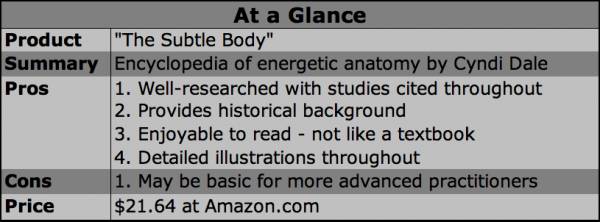
One of my favorite things about working in the health and fitness industry is learning about all the different approaches to wellness. For example, I’ve always been interested in the similarities and differences between Western and Eastern thought. In fact it was one of the things I focused on in my graduate studies in philosophy. This interest also carries over into their approaches to health and wellness. However, I have very little educational background in Eastern medicine, so I was glad to have the opportunity to read Cyndi Dale’s book, The Subtle Body: An Encyclopedia of Your Energetic Anatomy.
The Subtle Body is an excellent introductory text for anyone who wants to learn more about integrative medicine. The book is an interesting read with lots of historical background and rigorous research. Although it might be a bit basic for people who are already knowledgeable about the subject matter, for the serious beginner it’s a great place to start.
The Subtle Body focuses on the subtle energies and how they manifest themselves outwardly. What are the subtle energies? Dale explains:
We can’t see all the energies that keep the body healthy…Those we can see are called physical, or measurable, energies. Those that we can’t yet perceive are called subtle energies. Subtle doesn’t mean delicate. In fact, science is beginning to suggest that the subtle – the as yet immeasurable – actually directs the measurable and forms our physical framework.
As you can imagine, there’s a lot of information covered in this book. The Subtle Body is organized into six parts:
- Energy and Energy Healing
- Human Anatomy
- Energy Fields
- Channels of Energy: Channels of Light
- Energy Bodies: Chakras and Other “Light Switches”
- Energy Practices
If you are new to these topics, I would recommend reading the book all the way through, since each chapter builds on the next. Here are three things I liked most about The Subtle Body:
1. Integration of Western and Eastern practices: Dale notes that “Western and Eastern methods seemed diametrically opposed, and the schism between then seemed unsurpassable, until practitioners and patients noticed that the two approaches enhance one another. With this discovery, a new health care process was born, termed integrative care: the marriage between West and East.” This integrative approach can be observed throughout the book. For example, Dale includes an entire chapter on human anatomy which, although quite basic and straightforward, acts as a prelude to the chapters on subtle anatomy. As Dale says, “While the rules governing the physical and subtle systems are different, these structures are intimately and intricately tied together. For this reason, it is important to understand them both.”
2. Accessibility: Although this book is not easy reading – after all, as the title says, it is an encyclopedia of subtle anatomy – Dale did a great job making her book accessible and enjoyable to read. The book is extremely thorough and covers a huge range of material in a little over 400 pages. I was impressed with the concise explanations Dale provides and also her obvious extensive research. She does an excellent job of being concise in her explanations without being overly brief or skimming over the material. I also found the diagrams, illustrations, and sidebars helpful in illustrating the concepts Dale presents throughout the book. You’ll find detailed illustrations of reflexology, meridians, chakras, and more.
3. Scientific, evidence-based information throughout: Throughout The Subtle Body, Dale cites numerous studies, both recent and older, to support and illustrate the theories she presents. For example, the chapter “Scientific Principles Meet Chakra Theory” outlines various studies that have demonstrated the science of the chakras. The 10-page bibliography is also full of resources readers can look to for further information and evidence.
I talk to a lot of people who use the treatments outlined in The Subtle Body with great success, and have also used some of them myself. This book taught me about the theories behind wellness practices like acupuncture, reflexology, Reiki, aura-soma therapy, Ayurveda, and other modalities. If you are drawn to a more holistic approach to medicine but want to learn more about the ‘why’ behind it, I recommend The Subtle Body as a place to begin.
“The Subtle Body” is available for $21.64 at Amazon.com.






